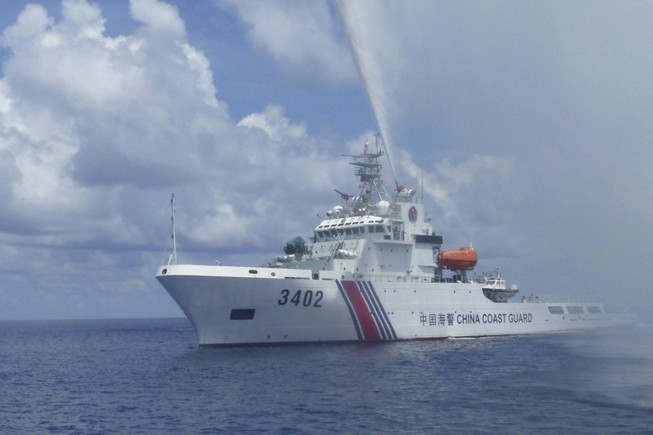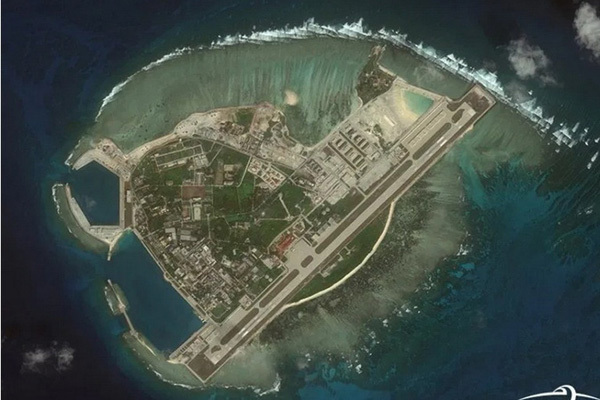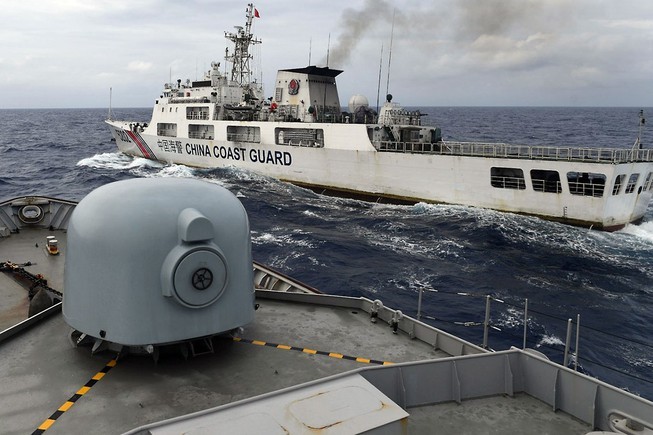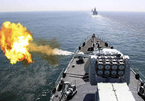China's policy in the East Sea (internationally known as the South China Sea) in 2020 remains unchanged: Promoting illegal claims, while further undermining the claims of Southeast Asian countries through on-field activities as well as domestic policy and propaganda activities.
Aggression on the field
In 2020, China continued to use outposts on the Hoang Sa Archipelago (Paracel Islands) and Truong Sa Archipelago (Spratly Islands) of Vietnam to support naval and coast guard operations.
Since the beginning of 2020, Chinese maritime law enforcement vessels have been present continuously in the East Sea. Its 5302 coast guard vessel was present at a number of island features of Spratly Islands in March.
 |
|
The Chinese coast guard force has become increasingly aggressive in the East Sea, threatening ships of other countries. Photo: SCMP/AP
|
At 3 a.m. on April 2, 2020 when a Vietnamese fishing vessel was operating in the waters of Truong Sa Archipelago, it was attacked by a Chinese ship and it sank. The next day, China threatened two other Vietnamese fishing boats which came to help the sunken ship and took them to Phu Lam (Woody) Island in Vietnam’s Hoang Sa Archipelago. In the evening of that day, China released these two ships and eight fishermen from the sunken fishing boat.
Derek Grossman, senior defense analyst at RAND (USA) said that the case in which a Vietnamese fishing ship was attacked by a Chinese coast guard vessel and sunk showed that "China is ready to use force to ensure its East Sea claims".
On April 23, 2020 Philippine naval ships patrolling the area around the Malampaya oil field were pointed at by the Chinese warship 541. On May 5, 2020 three Chinese Coast Guard ships appeared near the Scarborough Shoal in the East Sea. About 40 nautical miles away, a Filipino ship was drilling for oil exploration. In addition, the Chinese coast guard illegally confiscated fishing equipment of a Filipino fisherman. The Philippine Department of Foreign Affairs sent a diplomatic note protesting this action.
In the Nam Con Son basin, China encroached upon Vietnam's exclusive economic zone when on the morning of July 15, 2020 Chinese coast guard ships entered block 06.01, where Vietnam was conducting oil and gas exploration activities, for the 4th time.
In addition, China also deployed reconnaissance aircraft on Chu Thap (Fiery Cross Reef) of Vietnam’s Truong Sa archipelago. Jane's (UK) news site on May 12,2020 cited satellite images showing the Chinese navy’s aircrafts on the Fiery Cross Reef.
In August, the Chinese army deployed H-6J bombers to Woody Island. In October, they dispatched ships and aircraft to track the US John S. McCain guided-fire destroyer when this ship was conducting free navigation operations (FONOP) near Hoang Sa Archipelago.
Using domestic law to reinforce unauthorized claims
Establishment of "Xisha" and "Nansha"
On April 18, the Ministry of Civil Affairs of China blatantly announced that the State Council had just approved the establishment of the so-called "Xisha" and "Nansha" of Sanya City, Hainan Province.
According to the Chinese side, the "Xisha authorities" manage the islands of the so-called “Xisha archipelago” (Hoang Sa archipelago of Vietnam), the Macclesfield and the surrounding waters.
 |
|
Phu Lam (Woody) Island, which belongs to Hoang Sa archipelago of Vietnam, is illegally occupied by China. Photo: CSIS/AMTI
|
China placed the so-called "Xisha authorities" on Phu Lam Island - the largest structure in the Hoang Sa archipelago, while the "Nansha authorities" "manages" the islands of the “Nansha archipelago” (Vietnam’s Truong Sa Archipelago) and its surrounding waters, the so-called "Nansha authorities" are stationed in the Fiery Cross Reef - a structure belonging to Truong Sa Archipelago that China militarized recently.
Promoting civil activities on artificial islands
China is building self-sufficiency of artificially entities that were illegally built in the East Sea to bring more people, including soldiers and "civilians", to these places.
The Chinese navy teamed up with Chongqing University to test new technology on a 300 square meter of land in Phu Lam Island and after one month they harvested more than 750 kilograms of vegetables thanks to the technology of growing vegetables on sand. This technology will be replicated to other entities illegally occupied by China in the East Sea.
Declaring standard titles for illegally-occupied entities
On April 19, the Ministry of Natural Resources and the Ministry of Civil Affairs of China announced the so-called "standard titles of 25 islands and rocks in the East Sea" and "55 geographic island features on the bottom of the East Sea".
These entities are concentrated mainly in the western part of the East Sea, located along the so-called "cow's tongue line". Notably, among these entities there are shoals located deep within Vietnam's exclusive economic zone, and some are less than 60 nautical miles from the Vietnamese coast or about 50 nautical miles from the Vietnamese baseline.
A list of 80 island features was posted on the website of China's Ministry of Civil Affairs, changing the concept of "coastal waters".
China recently announced the amended (effective from August 1, 2020) "Technical rules for inspection according to the law of ships in domestic voyages" which was issued in 1974.
In this document, China established the so-called "Hainan-Xisha navigation water". This area is located between 2 points on Hainan Island and 3 points on the Hoang Sa Archipelago.
China has also changed the term, calling this area "coastal water", replacing the previous "offshore water" phrase. Meanwhile, the islands of the Hoang Sa Archipelago only have a territorial sea of 12 nautical miles, which is incapable of creating exclusive economic zones to create "coastal zones" as determined by China.
Announcing the newly revised Armed Police Law
On June 20, Chinese President Xi Jinping signed an order to publish the newly revised Law on People's Armed Police Force. The new law makes it clear that armed police are responsible for enforcing law enforcement at sea through Coast Guard forces.
Under this law, the Coast Guard is more integrated into the military forces, participating in training, drills and rescue operations with the Navy. And in emergency situations, the Central Military Commission will assume power to control the Coast Guard.
 |
|
A Chinese naval vessel approaches the Indonesian naval vessel that is on patrol near the Natuna Islands.
|
This move is aimed at strengthening cooperation between the Coast Guard and the military, with the aim of increasing pressure on the East Sea and other disputed areas. With the revised law, the Coast Guard is actually "China's second naval force" at sea.
Announcing the draft law, giving many privileges to the Coast Guard
The Coast Guard Bill was announced by Beijing on the website of the National People's Congress on November 4 for referendum until December 3.
This bill empowers the Coast Guard, including the use of weapons, when national sovereignty, sovereign rights and jurisdiction are infringed upon by foreign organizations or individuals at sea or in the face of the risk of being illegally violated.
The artificial islands that China illegally filled, renovated and built in the East Sea are placed within the scope of the Coast Guard’s protection.
The Coast Guard is allowed to remove constructions built by foreign countries in waters under "management" of this force. In addition, the Coast Guard is allowed to confiscate and destroy foreign ships if they "illegally encroach on the waters" of China.
It can be seen that the bill is a step to strengthen the cooperation between the Chinese Coast Guard and Chinese Navy, creating a premise for the Coast Guard to increase its presence in the seas.
Fishing ban
The fishing ban in the East Sea started from 12 a.m. on May 1 to 12 p.m. on August 16, 2020. The restricted area stretches from the northern waters of the East Sea to 12-degree north latitude, including part of the Gulf of Tonkin and Hoang Sa archipelago under Vietnamese sovereignty.
Propaganda of false sovereignty claims
China has issued irrational sovereignty claims in the East Sea through many forms such as inserting the "cow's tongue line" in conference documents...
On March 16, on Facebook and Twitter of the Chinese Embassy in Italy, an article about the solidarity between the two countries attached a picture of the "cow's tongue line".
China has subtly incorporated the "cow's tongue line" in movies, from "Operation Red Sea" (March 2018), "Abominable" in October 2019, to "Go Ahead" in 2020.
Rejecting the Permanent Court of Arbitration (PCA)’s ruling, interpreting the UN Convention on the Law of the Sea (UNCLOS) in a way that benefits China
Since the PCA issued its ruling in 2016, Chinese scholars have written a series of articles rejecting the PCA’s authority as well as the PCA’s ruling.
China also interpreted relevant provisions of the UNCLOS in its own favor. They interpreted Article 8 of the Foreword: "Matters not covered by the Convention will continue to be governed by the rules and principles of general international law" to affirm that "UNCLOS does not cover all matters at sea".
Since then, China has interpreted and applied international practice in its own favor, making claims on the establishment of baselines and territorial waters of an archipelagic state to apply to the Truong Sa Archipelago (Spratlys) and Hoang Sa (Paracels), or making claims to "contiguous waters" and sovereignty over "related waters", concepts that do not appear in international law.
Directing criticism to the outside, especially the US
Articles by Chinese authors all lead to the conclusion that the US is a key factor "destroying a stable peace situation" and "militarizing" the East Sea, or that the US is the country that wants to dominate the East Sea through the exercising of freedom of navigation in this sea.
China has tried to spread and advertise itself as a peace-loving, responsible, country that is compliant with international law.
But in reality, these images and China's actions are not compatible with each other. China's propaganda about the East Sea is mostly wrong, but it promoted propaganda to make these wrong views ingrained into the perception of domestic and international public opinion.
Hoang Viet

China changes sovereignty claim in the East Sea: hope or illusion?
“This is the time for China to give up the 9-dash line. This does not affect their interests,” said Dr. Li Nan, a research fellow at the East Asian Institute, National University of Singapore, at a recent online seminar on the East Sea.